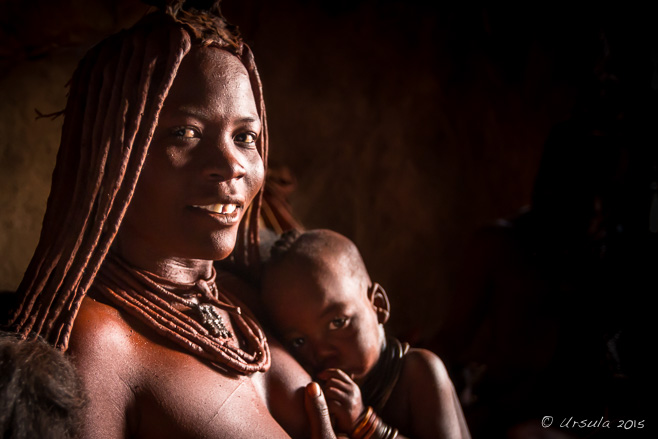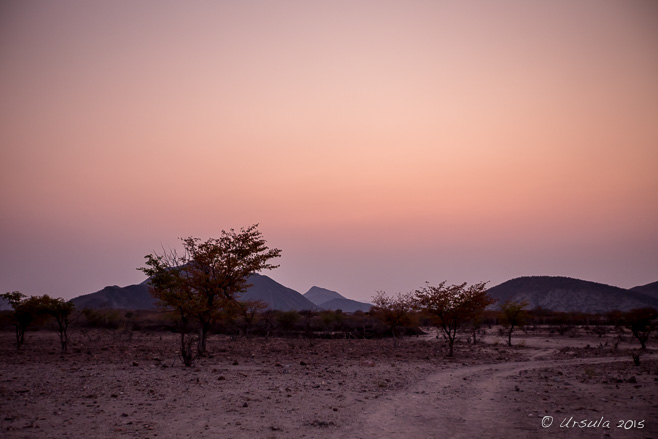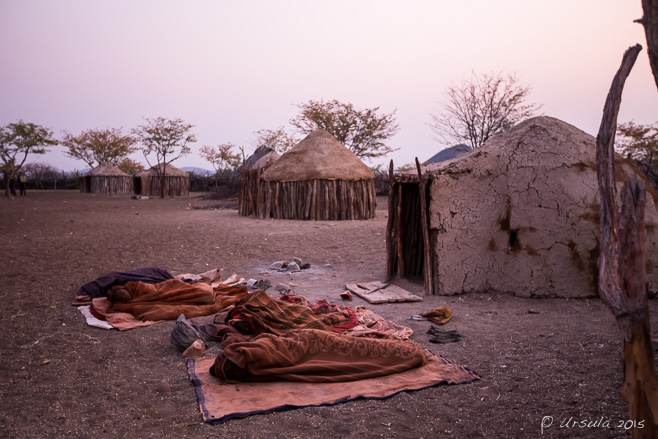
Mother and Nursing Child
Winter mornings are cold and dark in the huts of Otjomazeva, a kraal village in the Kunene Region of Namibia, but the people are warm and welcoming.
The Solstice (Yule or Litha – depending which hemisphere you are in) has just passed. Today is Christmas Eve here in Australia.
It makes me think of my family – scattered as they are – and of the families I have met in my travels. These families can take very different forms from the “norm” I grew up with (more on that some other day), but the core human bonds are recognisable wherever you go.
Earlier this year, I had the great privilege – thanks to photographer Ben McRae, Pedro Ferrão Patrício from Photoburst, and Namibian guide Morne Griffiths – of spending some time with traditional tribal Himba people. We were welcomed into Otjomazeva, a tiny kraal village near Epupa in Namibia.
There are about 50,000 indigenous Himba (singular: OmuHimba, plural: OvaHimba) people living on both sides of the Kunene River: in the Kunene region (formerly Kaokoland) of northern Namibia and in Angola. Semi-nomadic pastoralists, the Himba quite consciously maintain their cultural traditions and subsistence lifestyle.
I took hundreds of photos during my visits to the village, some of which I’ll post at another time. Right now, I’d like to just share just a few pictures of the simple village itself, and some portraits of a Himba woman and her child.

Otjomazeva Morning
Sleep – as they say – is over-rated. It was very early – quiet, cold, and dark – when we left our campsite. The pre-dawn light was pale and pink as we approached the Otjomazeva kraal.

Morning Rolls
It was still dark when we entered the kraal (with prior permission, of course) and I thought the “logs” in front of the huts were piles of donated blankets we had dropped off in the village the day before …

First Stirrings
… until one of them moved! There is not enough room in the huts for everyone, and many of the community slept outside, rolled in their blankets against the winter cold.

Morning Huddle
Noiselessly the day slowly comes to life. People gather around meagre fires waiting for the porridge to boil.

Tall and Beautiful
This young woman’s regal bearing captured my attention, as she stood, wrapped in her soft cow hide.

Mother and Child
She, her wrap, and her baby girl are coloured with the ochre paste (Otjize) that Himba women wear all over their skin and hair.

Himba Mother
The unique Himba hairstyle worn by married women is created by weaving long hair extensions – from goat or cow hair, and often including some of their husband’s hair – around the head, and coating these plaits with the ochre paste. Babies generally have their heads shaved, sometimes with a little tuft left on the top.

Applying Ochre Paste
The women are surprisingly happy to have myself and one of my companions inside their hut as they go through their daily ritual of re-applying the otjize. It is pitch black in the huts – the only light is from the low open doorway and the odd holes in the wattle and daub walls. Even so, you can just see the sculptured sheepskin Erembe headpiece that our Angolan visitor has put back on after she re-pasted her hair.

Mixing Otjize
The paste of liquified butterfat and ochre has a wonderful perfume, thanks to the resin of the omuzumba shrub. It’s baby’s turn to be rubbed with the paste, and she sits watching me while her mum prepares it.

Chatter
This woman is an extended family member who is visiting from neighbouring Angola. Her time in the village is spent catching up on local gossip. When she smiles, you can see the gap in her front teeth: traditionally, both boys and girls around age twelve have the front bottom teeth (incisors) knocked out and the two top front teeth filed into an upside “V” . …

Smiling Profile
… This seems tragic to me, especially considering how beautifully white their teeth are!

Mother and Child

Mother and Child

“It Takes a Village”
Children in the Himba village are never far from an arm or a lap – or a comforting breast.
All around the world, families and friends gather to celebrate. Where I grew up, the celebrations this time of year were either for Christmas or Hanukkah. But, if there is one thing travel teaches you, it is that “family” and “celebration” take very different forms the world over.
So, whether you are celebrating Christmas or Hanukkah; Rohatsu or Mawlid an Nabi or Zarathosht Diso; Solstice – or nothing at all; I hope you can take the time to appreciate your family, and to make peace within your community. In the words of Charles Dickens:

We are, indeed, fellow passengers.
Happy Holidays to You and Yours!
Pictures: 17August2015



















.png)


[…] I had the wonderful privilege of spending time with some Himba people in Northern Namibia (see: Mother and Child; Model Shoot). The Himba are a beautiful, proud tribe who have deliberately resisted integration […]
[…] are immediately recognisable by their distinctive hairstyles (see: Mother and Child; Women of the Himba; Himba Model Shoot), which are determined by their age, gender and […]
[…] I had the wonderful privilege of spending time with some Himba people in Northern Namibia (see: Mother and Child; Model Shoot). The Himba are a beautiful, proud tribe who have deliberately resisted integration […]